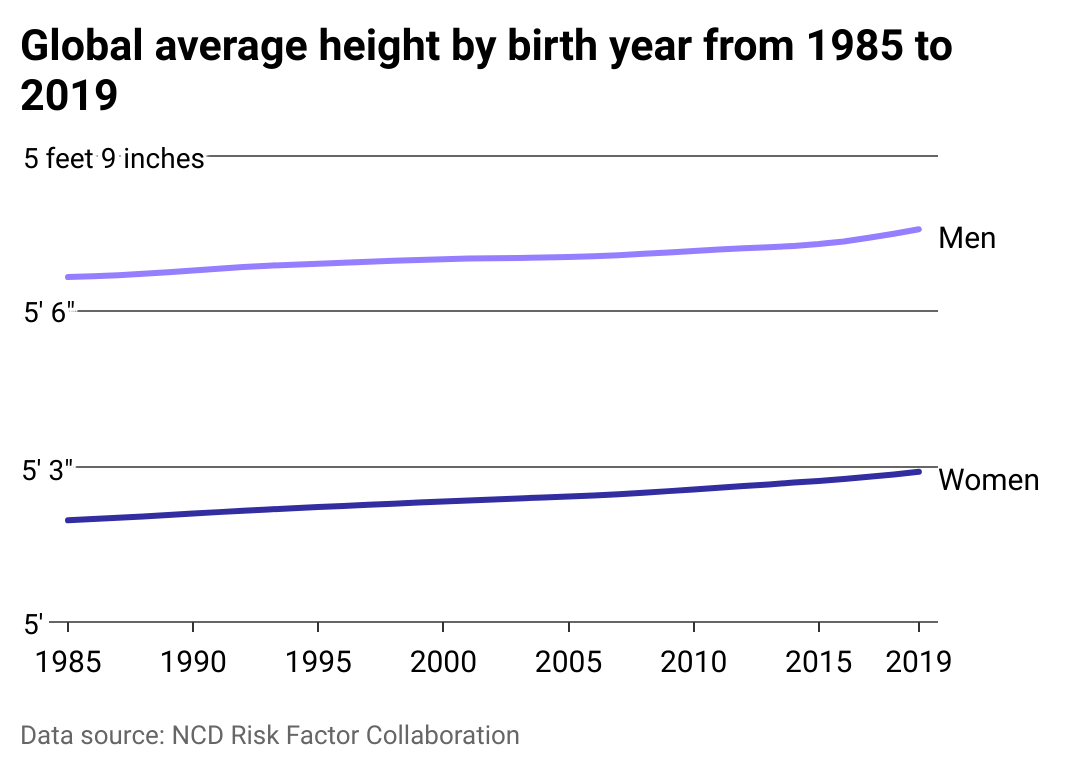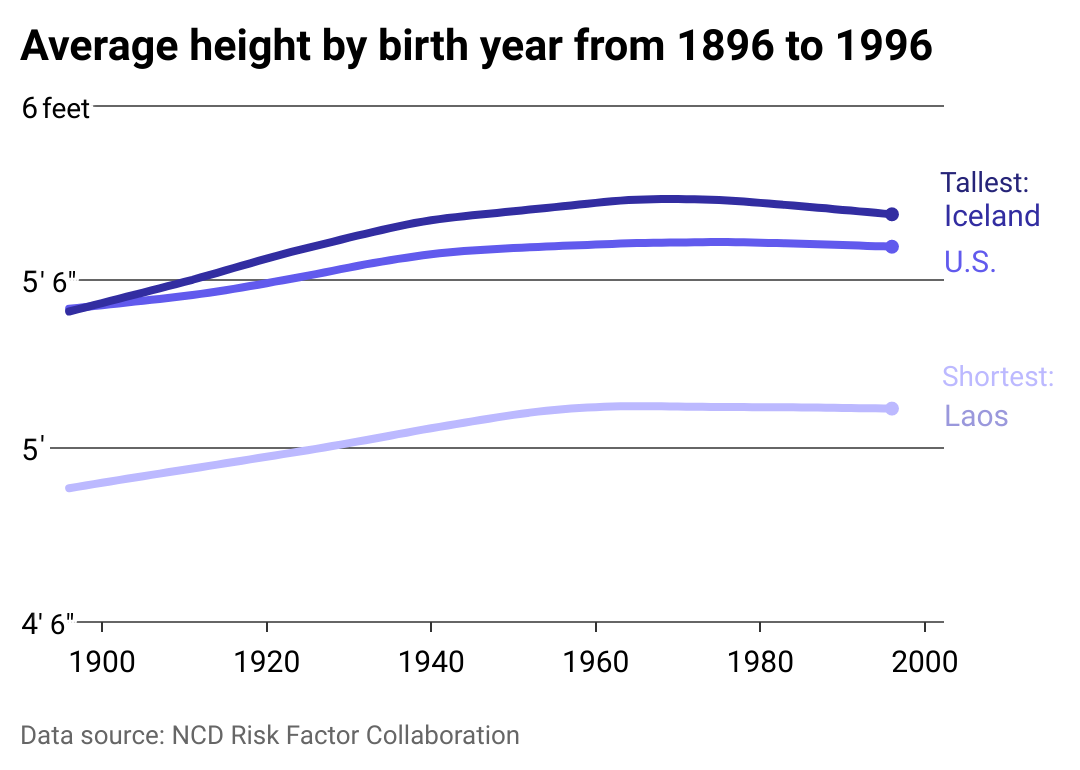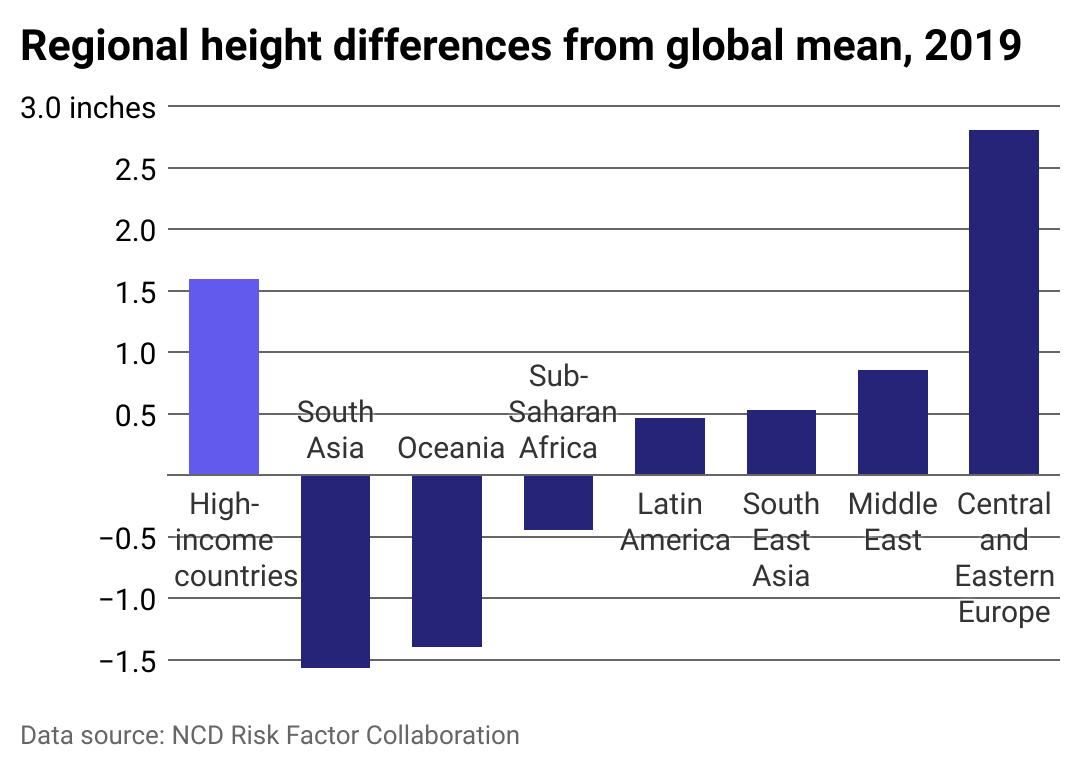How human height has changed over time—and what might be behind it

Elizaveta Galitckaia // Shutterstock
How human height has changed over time—and what might be behind it
Father and son look at skeletons in museum exhibit.
Genetics partially influences height, but other factors, such as nutrition, also affect how tall you become as an adult. The average height of a population can indicate the health of its people since things such as childhood illness and poor nutrition during pregnancy and childhood can stunt a person’s growth.
GigaCalculator examined human height trend data from the NCD Risk Factor Collaboration to see how average height has changed worldwide over time. NCD-RisC compiles height data in partnership with the World Health Organization, Imperial College in London, and from population-based surveys.
Being taller is associated with longevity and higher income and education, and taller people tend to be at lower risk for heart disease and stroke. However, taller stature is also associated with an increased risk of certain cancers.
Some countries, such as the U.S. and the U.K., have seen the average height of their population level off over the last several decades—the U.S. has dropped rather precipitously in the world rank of average height, from third for men and fourth for women in 1914 to 37th and 42nd, respectively, today. Other countries, such as those in Latin America and East Asia, have seen average heights among their populations increase. And countries in Africa and the Middle East have seen a decline in average heights.
Differences in average height, taken together with increased reports about obesity, raise a proverbial red flag about public health, according to a 2016 study looking at trends in human height.
![]()

IR Stone // Shutterstock
Early humans were 5 feet tall on average
Museum display of skulls showing human’s evolution.
Neanderthals, our closest human relatives, lived in Europe and Asia an estimated 40,000-130,000 years ago, though evidence of their existence dates back more than 400,000 years. Based on what archeologists have been able to glean from historical research, males had an average height of 5 feet and 5 inches, while females were small, at an average of 5 feet and 1 inch.
Height and weight have not consistently increased together; early Neanderthals tended to be taller than those who came later, but their weight remained the same. Their short, stocky bodies gave them an advantage in colder climates. Their short lower leg and lower arm bones may also have given early Neanderthals an advantage when hunting.

GigaCalculator
Global average height increased steadily until the 1980s with little fluctuation
Chart showing average global height over time, increasing since the late 1800s and plateauing in the 1980s.
Scientists analyzed human growth patterns in different parts of the world over the last century and found height did not increase linearly. In the previous 30 years, increases in height have plateaued in high-income Western countries.
Researchers have also observed this trend among elite athletes. After increasing in the 1950s and ’60s, athletes’ heights have leveled off, most notably in sports that select for particularly tall players, such as basketball.
![]()
Pixel-Shot // Shutterstock
Height is often an indicator of good health, reflecting well-balanced diets and good health care
A young boy standing before a height chart.
When researchers analyzed data from the Cebu Longitudinal Health and Nutrition Study in the Philippines, they found that healthier diets with a greater variety of foods were associated with increased height in boys. Each additional 100 calories consumed daily led to significant increases in boys’ heights and a slightly smaller but still significant increase in height in girls.
However, the effects of caloric intake decreased with age. And each additional 100 calories consumed led to an increase in height for children and teens of low socioeconomic status, but not for those of higher socioeconomic status.
One of the most influencing factors of human height is the amount of protein and minerals such as calcium and vitamin D a person gets in childhood, during their developmental years. Projected global population increases are also likely to lead to a manifold increase in the demand for animal-derived protein by 2050. Global protein consumption varies by region, making food scarcity an influencing factor in height and weight.

GigaCalculator
The US saw rapid increases in mean height for the first half of the 20th century
Line chart showing average height in the US compared to the tallest country, Iceland, and the shortest, Laos.
Average human height in countries such as the U.S., U.K., and Japan has leveled off at around 5 feet and 10 inches over the last few decades. However, height is still increasing in places such as Latin America. These increases are likely the result of better maternal health and nutrition and greater access to health care. The findings suggest that human height may have reached a limit or a convergence point called a biological asymptote under favorable conditions.

GigaCalculator
Higher-income countries rank among the highest in the world for tallest residents
Bar chart showing the regional differences in height from the global average. High-income countries are much taller than the average.
High-income countries (listed here) are excluded from their respective region groups (this data also includes children so the global average is less than the earlier slide).
Studies have examined the relationship between height and body mass index with socioeconomic status. An analysis of data from the UK Biobank published in 2016 found that lower socioeconomic status correlated with shorter stature and higher BMI, though such associations differed between the sexes.
Shorter height and lower socioeconomic status appeared to be more strongly linked for men, whereas the link between higher BMI and lower socioeconomic status was paramount for women. These findings imply that taller people, especially men, are associated with higher attainment in education, employment, and income levels. However, lower income levels are associated more closely with overweight people—and within that subset, particularly women.
This story originally appeared on GigaCalculator and was produced and
distributed in partnership with Stacker Studio.